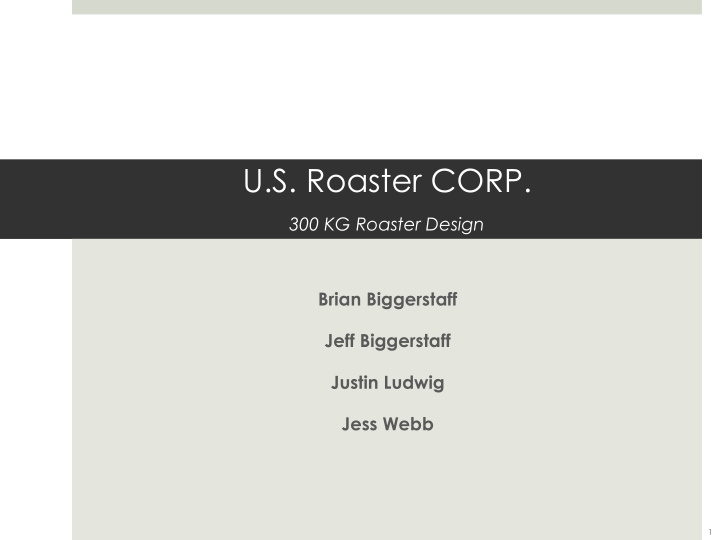



U.S. Roaster CORP. 300 KG Roaster Design Brian Biggerstaff Jeff Biggerstaff Justin Ludwig Jess Webb 1
Mission Statement / Objectives To assist U.S. Roaster Corp.in the design of a 300 kg coffee roaster by modifying the current smaller roaster designs Finalize materials for the new drum and heating box that meet client expectations Choose a material for the drum that allows minimal expansion to prevent rubbing on the edges of casting 2
Roasting Process Green beans enter from the top • via funnel Beans enter drum and are spun • at desired temperatures until “2 nd crack phase” Once desired roast is reached, • the beans are ejected into a cooling pan and mixed http://www.youtube.com/watc • h?feature=player_detailpage& v=BUhpg9RbafM 3
Roasting Process Cont. Bean stages: Green stage Yellow Stage: 200 F – 250 F Light Brown Stage: 250 F – 300 F First Crack: 355 F – 400 F Second Crack: Up to 500 F Process time: 8 – 13 Minutes depending on desired roast 4
Desired Modifications Using a different type of metal with lower thermal expansion properties Currently, the drum’s expansion causes rubbing against the casting wall and also creates a gap where beans can fall out Change the location of heating source on the drum Currently, heat sets directly under the drum causing temperature control issues Using a different system for the support of the drum Currently, a shaft supports the drum’s weight. With the upscale and addition of weight, a roller support system system is desired 5
Scope of Work Regularly meet and discuss progress with project affiliate Patent research on roaster designs Obtained a general knowledge of the process of coffee roasting Researched different types of steel to withstand high temperatures Investigated 4 alternate roaster designs 6
Patent Searches Most patents applied to small scale designs United States Patent US 7,003,897 Coffee Roaster Drum with Rocker Arms International Patents WO 2009/075893, WO 03/011050 Recirculated Airflow, Filtered Exhaust Airflow 7
Alternatives Considered Materials Considered Roaster Designs Considered 8
Materials Considered US Roaster Corp currently uses 304 stainless steel Our client advised us to look into 400 series stainless Find the metal that is applicable to the process Find a supplier Narrowed the metal to three choices 422 Stainless 430 Stainless 436 Stainless 9
Materials Considered Metal Type Property Notes 304 Stainless Expands too much for the application. Dan has had trouble with this expansion RA 330 Similar properties to 304 Stainless 410 Stainless Less resistant to corrosion than 430, used a lot in knives and kitchen utensils 422 Stainless High temperature resistance up to 1200 degrees F, have not located a source 430 Stainless Good heat resistance up to 1500 degrees F, typical in gas burners and oil refinery equipment 436 Stainless High temperature applications such automotive exhaust applications Inconel Costly and very heavy, may be possible for the firebox 10
Materials Considered Metal Type 150 Kg ΔD (in) 300 Kg ΔD (in) 304 Stainless 0.347 0.478 RA 330 0.351 0.484 410 Stainless 0.245 0.338 422 Stainless 0.234 0.322 430 Stainless 0.238 0.328 436 Stainless 0.230 0.317 Inconel 0.294 0.406 11
Design Alternative 1 Use the current 150 kg roaster design scaled up to a 300 kg design Rotate drum about a shaft traveling through the center of the drum Change heated air flow to go through the center of the drum instead of heating the outside 12
Design Alternative 1 Pros US Roaster Corp is already familiar with this design Relatively simple Proven Cons Fatigue on the shaft Complications from drum expansion 13
Design Alternative 2 Similar to Design Alternative 1 Drum rests on rollers instead of having a shaft through the middle Drum rotation is driven by rollers 14
Design Alternative 2 15
Design Alternative 2 Pros Expansion Simplicity Addresses shaft loading issue Cons Patents Heating of rollers 16
Design Alternative 3 Stationary drum rotating agitators Apply hot air through the agitators Multiple heating elements for each agitator arm Multiple locations for applied heat Allows for more control of heat 17
Design Alternative 3 Pros Fewer issues with the drum expanding Centralized heating Even, controlled heating Cons The agitator will damage the beans Complexity 18
Design Alternative 4 Conveyor Oven Burners underneath Constant flow Vibrating conveyor belt to equally heat beans Similar to a pizza oven 19
Design Alternative 4 Pros Constant flow of roasted coffee No rotating drum so less worries about expansion Cons Design is too different and radical to implement Would need to design on a small scale before large 20
Freshman Project Responsible for designing the firebox Guidance for overall design and expansion calculations SolidWorks simulations for analyzing design Researching insulation materials Have to be safe for high temperatures, up to 2000 °F Long lasting and durable 21
Freshman Project 22
Conclusions Selection of Alternatives Design #1 or Design #2 430 or 436 Stainless Steel Future Work Finalize and draw selected design alternative Finalize metal selection based on client preference Finish working with the Freshman group on firebox design Test for drum expansion, air flow, and mixing optimization 23
Questions? 24
Recommend
More recommend